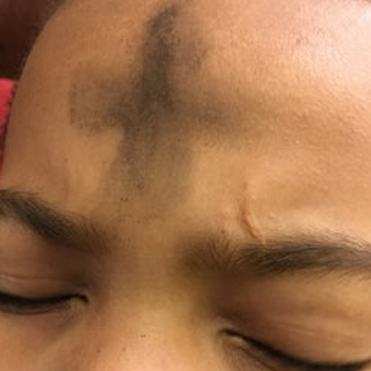by Elizabeth Hunter—
After the imposition of ashes, the kids and I traipse back to the pew. My youngest child stops in the aisle and whispers: “People are staring at my face. …Are people looking at my scar?” His eyes are anxious beneath the inky smudge, the barest suggestion of a cross on his forehead.
At first, I’m at a loss. Then I see, near the ashes, the faint scar from an early childhood accident that required stitches.
“Scar” is a rough-edged word with roots in several languages, including Latin (eschara), Greek (ἐσχάρα or eskhara) and Old Norse (skarð). Scars are proof that we can heal. Scars remain after collagen rushes in like a team of first responders, criss-crossing and filling in gaps to make new flesh. Scars remain in the muscle after a heart attack. Even your bellybutton is a scar—formed when your umbilical cord was cut. In other words, almost immediately after we enter this world, we are all scarred—for life.
There are emotional scars as well. God’s intention for us is abundant life. Yet we often fall into scarcity thinking about ourselves, about others, about our world. Our scars don’t go away, but they do not define us. The cross defines us. God rebuilds us.
Rebuilding us and our faith, as seminary professor and weightlifter Cheryl Peterson (p. 7) shares, is “not simply a matter of how strong” we are, but “our posture toward God, our receptivity of God’s love and power and strength, and our trust in God’s promise.”
In Scripture, people with scars often hear God’s messages at pivotal points along their faith journeys. Surprising encounters with angels—whether fierce or friendly—can involve comfort and challenge, help and warning, blessing and (sometimes) scarring.
Here’s a challenge: In Christa von Zychlin’s “Journeys with Angels” Bible study series (p. 24), can you find places that remind you of our human brokenness? What is the goal of the angelic activity near these biblical people? Do God’s messengers mirror God’s healing activity in the world? Remember that scars can be evidence of healing.
Perhaps some of the “angels” in your life may become more evident to you after reading Julia Seymour’s first installment of a 40-day Lenten devotional. It offers a way to pray for people who reflect the light of Christ as they work in often overlooked roles.
While filing back into the pew at the Ash Wednesday worship service, I tell my son that no one is looking at his scar. “Everybody has scars. Even Jesus,” I say. “If anybody is looking at you, it’s probably because there’s a big cross on your forehead. And they have that same cross too.”
We sit down in the pew. I hand him a pocket- sized mirror in a case that reads: “This is what bold looks like.” Pulling out the small piece of glass, he looks into it.
“Oh!” he says, astonished by the cross.
Elizabeth Hunter is editor of Gather.
This article is from the January/February 2021 issue of Gather magazine. To read more like it, subscribe to Gather.


